Statistics Assignment: Confidence Intervals and Sample Size
VerifiedAdded on 2022/09/18
|8
|641
|22
Homework Assignment
AI Summary
This statistics assignment solution covers confidence interval calculations, sample size determination, and proportion analysis. The solution includes detailed step-by-step calculations for constructing confidence intervals for the mean weight of hamburger buns and hot dogs, and for the propor...
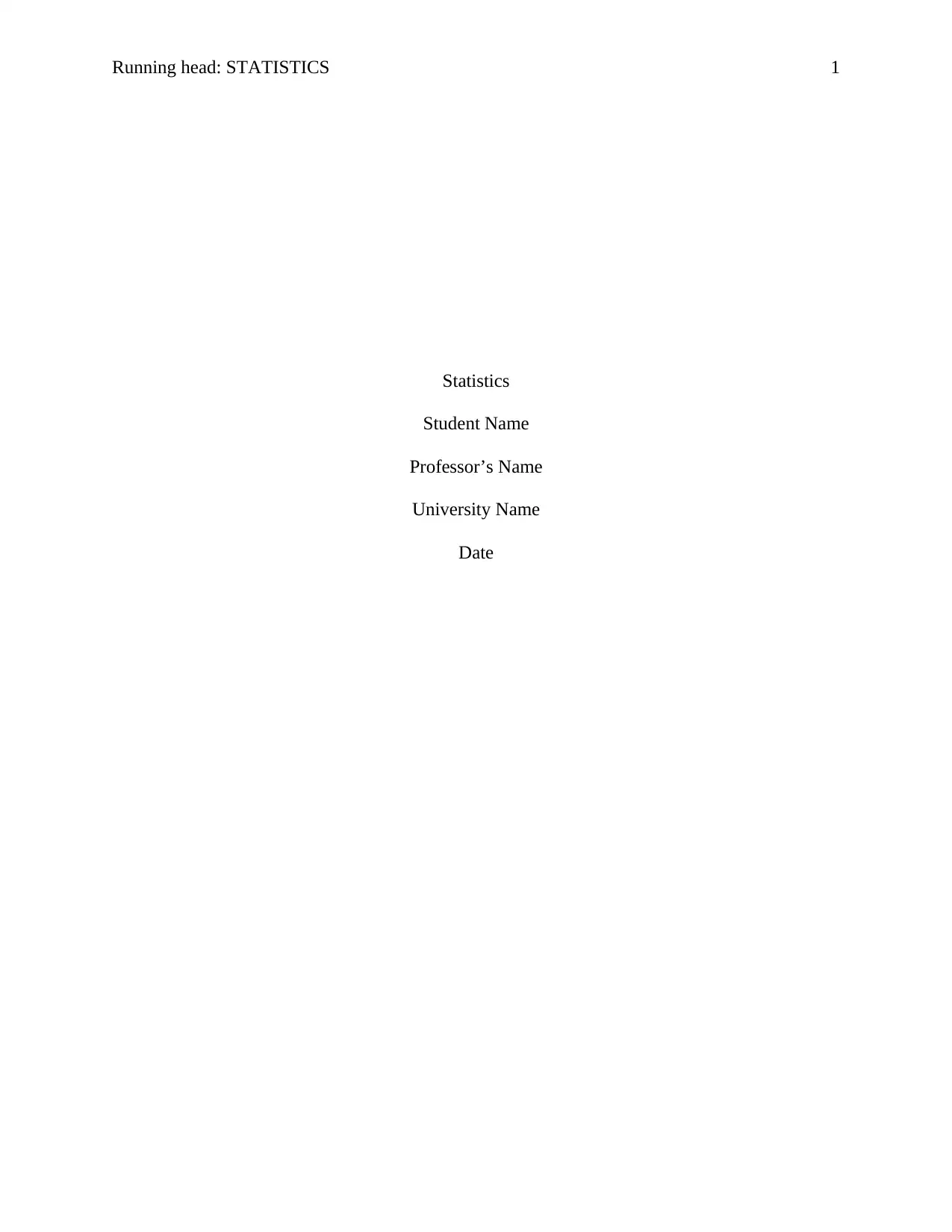
Running head: STATISTICS 1
Statistics
Student Name
Professor’s Name
University Name
Date
Statistics
Student Name
Professor’s Name
University Name
Date
Paraphrase This Document
Need a fresh take? Get an instant paraphrase of this document with our AI Paraphraser
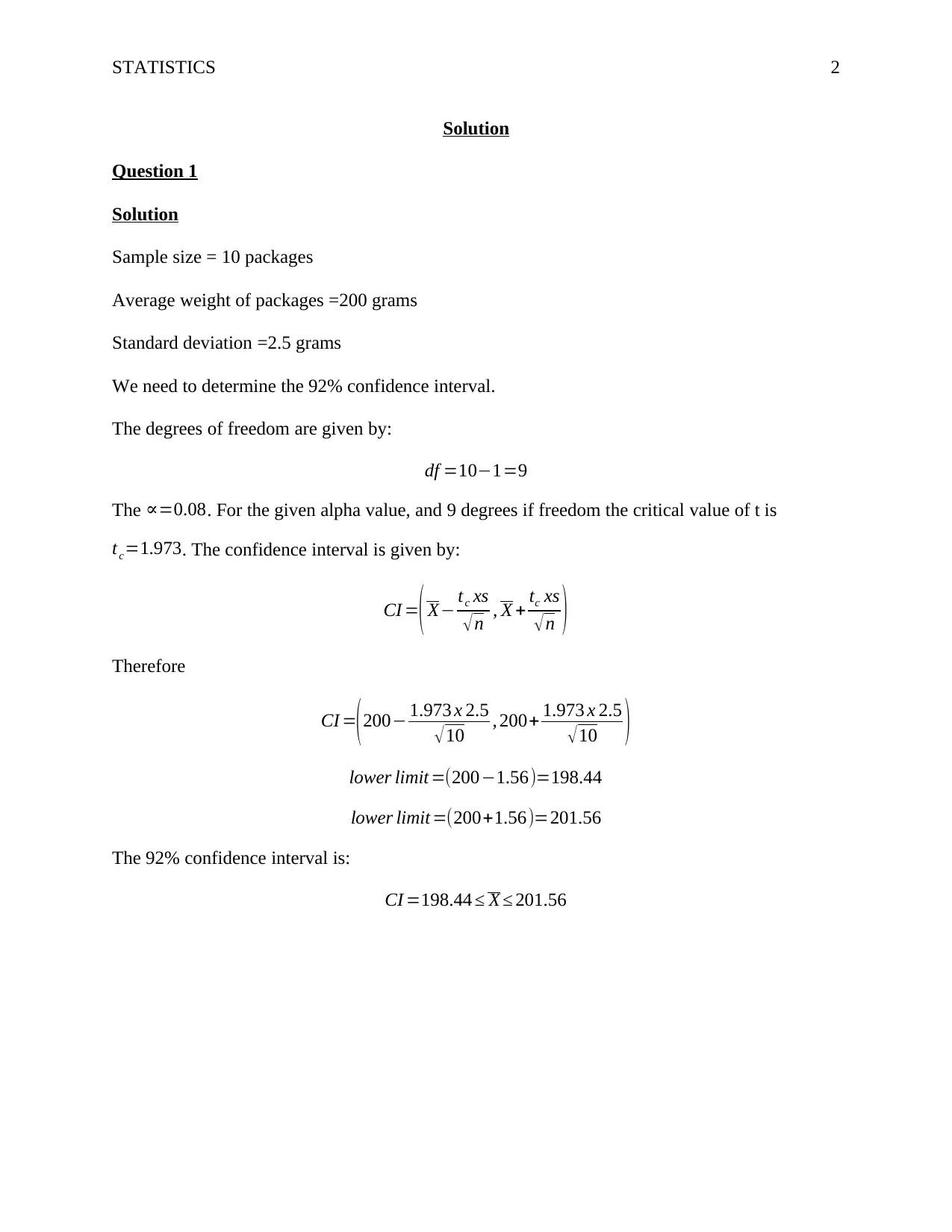
STATISTICS 2
Solution
Question 1
Solution
Sample size = 10 packages
Average weight of packages =200 grams
Standard deviation =2.5 grams
We need to determine the 92% confidence interval.
The degrees of freedom are given by:
df =10−1=9
The ∝=0.08. For the given alpha value, and 9 degrees if freedom the critical value of t is
tc=1.973. The confidence interval is given by:
CI =( X− tc xs
√ n , X + tc xs
√ n )
Therefore
CI =(200− 1.973 x 2.5
√10 , 200+ 1.973 x 2.5
√10 )
lower limit =(200−1.56)=198.44
lower limit =(200+1.56)=201.56
The 92% confidence interval is:
CI =198.44 ≤ X ≤ 201.56
Solution
Question 1
Solution
Sample size = 10 packages
Average weight of packages =200 grams
Standard deviation =2.5 grams
We need to determine the 92% confidence interval.
The degrees of freedom are given by:
df =10−1=9
The ∝=0.08. For the given alpha value, and 9 degrees if freedom the critical value of t is
tc=1.973. The confidence interval is given by:
CI =( X− tc xs
√ n , X + tc xs
√ n )
Therefore
CI =(200− 1.973 x 2.5
√10 , 200+ 1.973 x 2.5
√10 )
lower limit =(200−1.56)=198.44
lower limit =(200+1.56)=201.56
The 92% confidence interval is:
CI =198.44 ≤ X ≤ 201.56
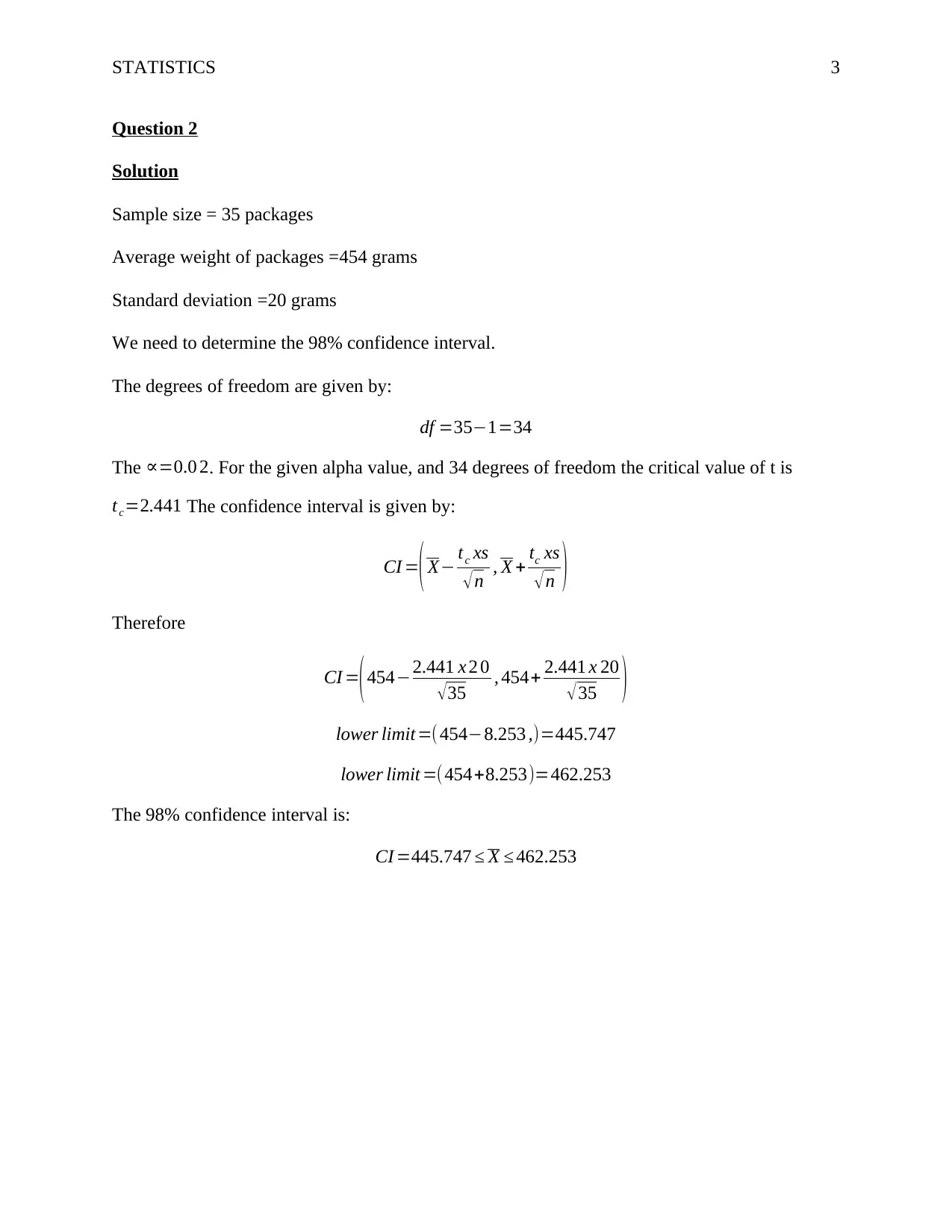
STATISTICS 3
Question 2
Solution
Sample size = 35 packages
Average weight of packages =454 grams
Standard deviation =20 grams
We need to determine the 98% confidence interval.
The degrees of freedom are given by:
df =35−1=34
The ∝=0.0 2. For the given alpha value, and 34 degrees of freedom the critical value of t is
tc=2.441 The confidence interval is given by:
CI =( X− tc xs
√ n , X + tc xs
√ n )
Therefore
CI =
(454−2.441 x 2 0
√35 , 454+ 2.441 x 20
√35 )
lower limit=(454−8.253 ,)=445.747
lower limit =(454+8.253)=462.253
The 98% confidence interval is:
CI =445.747 ≤ X ≤ 462.253
Question 2
Solution
Sample size = 35 packages
Average weight of packages =454 grams
Standard deviation =20 grams
We need to determine the 98% confidence interval.
The degrees of freedom are given by:
df =35−1=34
The ∝=0.0 2. For the given alpha value, and 34 degrees of freedom the critical value of t is
tc=2.441 The confidence interval is given by:
CI =( X− tc xs
√ n , X + tc xs
√ n )
Therefore
CI =
(454−2.441 x 2 0
√35 , 454+ 2.441 x 20
√35 )
lower limit=(454−8.253 ,)=445.747
lower limit =(454+8.253)=462.253
The 98% confidence interval is:
CI =445.747 ≤ X ≤ 462.253
⊘ This is a preview!⊘
Do you want full access?
Subscribe today to unlock all pages.

Trusted by 1+ million students worldwide

STATISTICS 4
Question 3
Solution
Total number of burgers =536, the number of burgers made with vegetarian meat =134. The
proportion of burgers made with vegetarian meat is given by:
proportion=134
536 =0.25
We need to determine 95% confidence interval of the proportion. The critical value for ∝=0.05
and ZC =Z1− ∝
2
=1.96. The confidence interval is:
CI =( ^P−Zc √ ^P ( 1− ^P )
n , ^P+Zc √ ^P ( 1− ^P )
n )
CI =( 0.25−1.96∗
√ 0.25 ( 1−0.25 )
536 , 0.25+1.96∗
√ 0.25 ( 1−0.25 )
536 )
lower limit =(0.25−0.037)=0.213
lower limit =(0.25+ 0.037)=0.287
The 95% confidence interval of proportion is:
CI =0.213 ≤ p ≤ 0.287
Question 3
Solution
Total number of burgers =536, the number of burgers made with vegetarian meat =134. The
proportion of burgers made with vegetarian meat is given by:
proportion=134
536 =0.25
We need to determine 95% confidence interval of the proportion. The critical value for ∝=0.05
and ZC =Z1− ∝
2
=1.96. The confidence interval is:
CI =( ^P−Zc √ ^P ( 1− ^P )
n , ^P+Zc √ ^P ( 1− ^P )
n )
CI =( 0.25−1.96∗
√ 0.25 ( 1−0.25 )
536 , 0.25+1.96∗
√ 0.25 ( 1−0.25 )
536 )
lower limit =(0.25−0.037)=0.213
lower limit =(0.25+ 0.037)=0.287
The 95% confidence interval of proportion is:
CI =0.213 ≤ p ≤ 0.287
Paraphrase This Document
Need a fresh take? Get an instant paraphrase of this document with our AI Paraphraser

STATISTICS 5
Question 4
Solution
Proportion that run behind the schedule = 10%=0.1
Margin of error =3%= 0.03
We need to determine the 90% confidence interval. The estimate of proportion=0.1. The critical
value for the significance level ∝=0 .9 is:
∝=1−0.9=0.1
∝
2 = 0.1
2 =0.05
From the Z-table
Zc=1.645
The minimum sample size required is:
^p=0.10
1− ^p=1−0.10=0.9
n=( Z∝
2
E )
2
x ^p (1− ^p)
n=( 1.645
0.03 )
2
∗0.10∗0.9=270.6
The sample size that could be required is =271.
The confidence interval is:
CI =( ^P−Zc √ ^P ( 1− ^P )
n , ^P+Zc √ ^P ( 1− ^P )
n )
CI =( 0.1−1.645∗
√ 0. 1 ( 1−0. 1 )
271 , 0.1+1. 645∗
√ 0. 1 ( 1−0.1 )
271 )
lower limit =(0. 1−0. 03)=0. 07
Question 4
Solution
Proportion that run behind the schedule = 10%=0.1
Margin of error =3%= 0.03
We need to determine the 90% confidence interval. The estimate of proportion=0.1. The critical
value for the significance level ∝=0 .9 is:
∝=1−0.9=0.1
∝
2 = 0.1
2 =0.05
From the Z-table
Zc=1.645
The minimum sample size required is:
^p=0.10
1− ^p=1−0.10=0.9
n=( Z∝
2
E )
2
x ^p (1− ^p)
n=( 1.645
0.03 )
2
∗0.10∗0.9=270.6
The sample size that could be required is =271.
The confidence interval is:
CI =( ^P−Zc √ ^P ( 1− ^P )
n , ^P+Zc √ ^P ( 1− ^P )
n )
CI =( 0.1−1.645∗
√ 0. 1 ( 1−0. 1 )
271 , 0.1+1. 645∗
√ 0. 1 ( 1−0.1 )
271 )
lower limit =(0. 1−0. 03)=0. 07
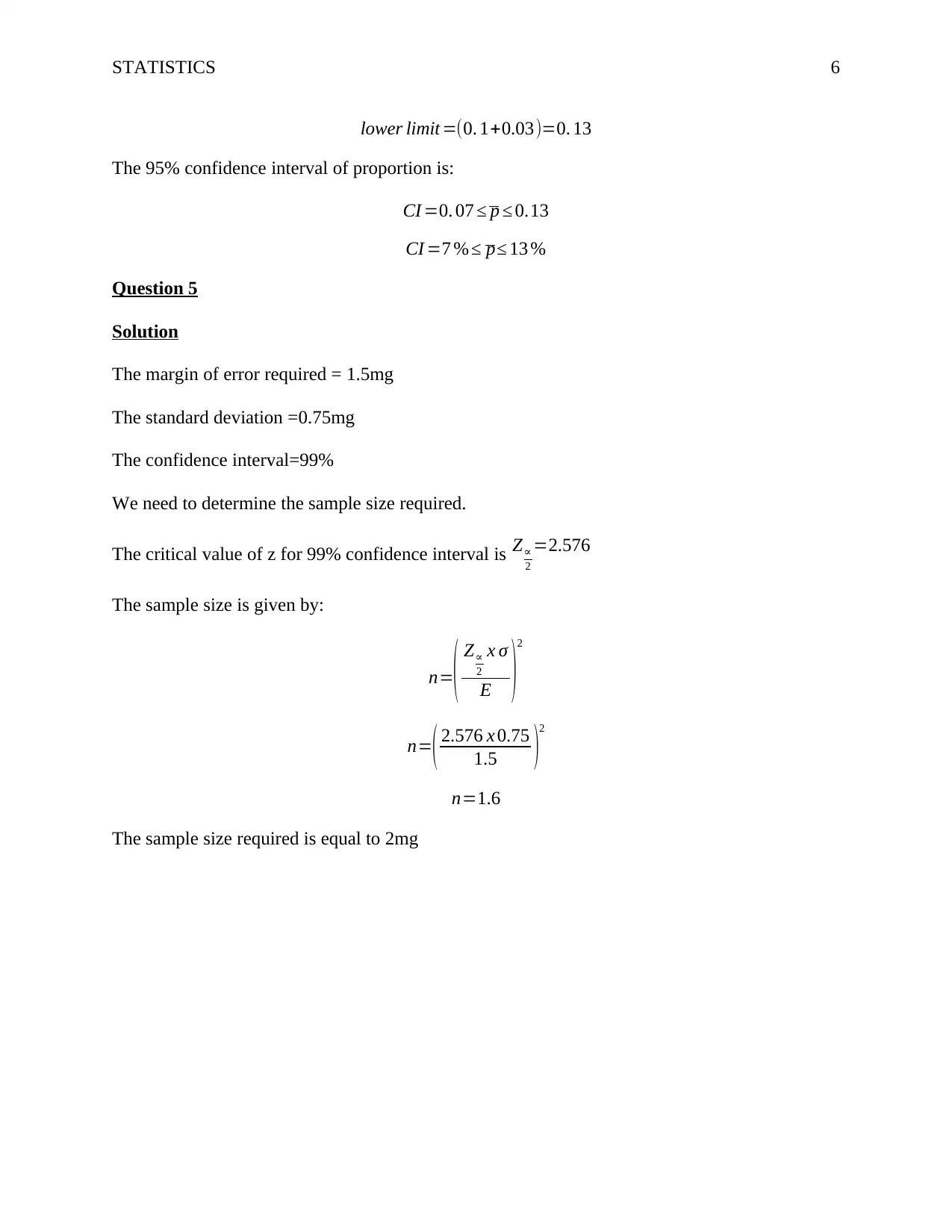
STATISTICS 6
lower limit =(0. 1+0.03)=0. 13
The 95% confidence interval of proportion is:
CI =0. 07 ≤ p ≤ 0.13
CI =7 % ≤ p≤ 13 %
Question 5
Solution
The margin of error required = 1.5mg
The standard deviation =0.75mg
The confidence interval=99%
We need to determine the sample size required.
The critical value of z for 99% confidence interval is Z∝
2
=2.576
The sample size is given by:
n=( Z∝
2
x σ
E )
2
n=( 2.576 x 0.75
1.5 )
2
n=1.6
The sample size required is equal to 2mg
lower limit =(0. 1+0.03)=0. 13
The 95% confidence interval of proportion is:
CI =0. 07 ≤ p ≤ 0.13
CI =7 % ≤ p≤ 13 %
Question 5
Solution
The margin of error required = 1.5mg
The standard deviation =0.75mg
The confidence interval=99%
We need to determine the sample size required.
The critical value of z for 99% confidence interval is Z∝
2
=2.576
The sample size is given by:
n=( Z∝
2
x σ
E )
2
n=( 2.576 x 0.75
1.5 )
2
n=1.6
The sample size required is equal to 2mg
⊘ This is a preview!⊘
Do you want full access?
Subscribe today to unlock all pages.

Trusted by 1+ million students worldwide
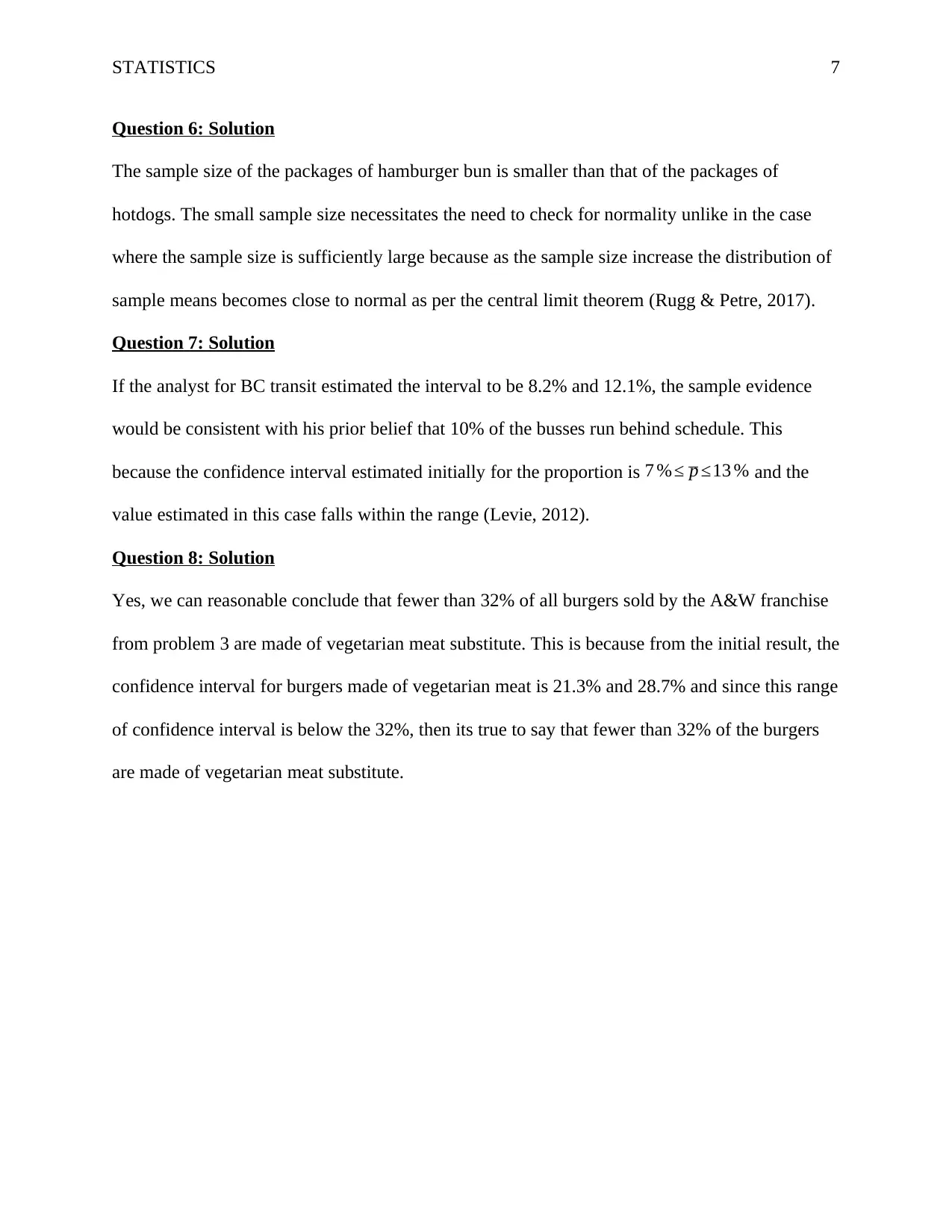
STATISTICS 7
Question 6: Solution
The sample size of the packages of hamburger bun is smaller than that of the packages of
hotdogs. The small sample size necessitates the need to check for normality unlike in the case
where the sample size is sufficiently large because as the sample size increase the distribution of
sample means becomes close to normal as per the central limit theorem (Rugg & Petre, 2017).
Question 7: Solution
If the analyst for BC transit estimated the interval to be 8.2% and 12.1%, the sample evidence
would be consistent with his prior belief that 10% of the busses run behind schedule. This
because the confidence interval estimated initially for the proportion is 7 %≤ p ≤13 % and the
value estimated in this case falls within the range (Levie, 2012).
Question 8: Solution
Yes, we can reasonable conclude that fewer than 32% of all burgers sold by the A&W franchise
from problem 3 are made of vegetarian meat substitute. This is because from the initial result, the
confidence interval for burgers made of vegetarian meat is 21.3% and 28.7% and since this range
of confidence interval is below the 32%, then its true to say that fewer than 32% of the burgers
are made of vegetarian meat substitute.
Question 6: Solution
The sample size of the packages of hamburger bun is smaller than that of the packages of
hotdogs. The small sample size necessitates the need to check for normality unlike in the case
where the sample size is sufficiently large because as the sample size increase the distribution of
sample means becomes close to normal as per the central limit theorem (Rugg & Petre, 2017).
Question 7: Solution
If the analyst for BC transit estimated the interval to be 8.2% and 12.1%, the sample evidence
would be consistent with his prior belief that 10% of the busses run behind schedule. This
because the confidence interval estimated initially for the proportion is 7 %≤ p ≤13 % and the
value estimated in this case falls within the range (Levie, 2012).
Question 8: Solution
Yes, we can reasonable conclude that fewer than 32% of all burgers sold by the A&W franchise
from problem 3 are made of vegetarian meat substitute. This is because from the initial result, the
confidence interval for burgers made of vegetarian meat is 21.3% and 28.7% and since this range
of confidence interval is below the 32%, then its true to say that fewer than 32% of the burgers
are made of vegetarian meat substitute.
Paraphrase This Document
Need a fresh take? Get an instant paraphrase of this document with our AI Paraphraser
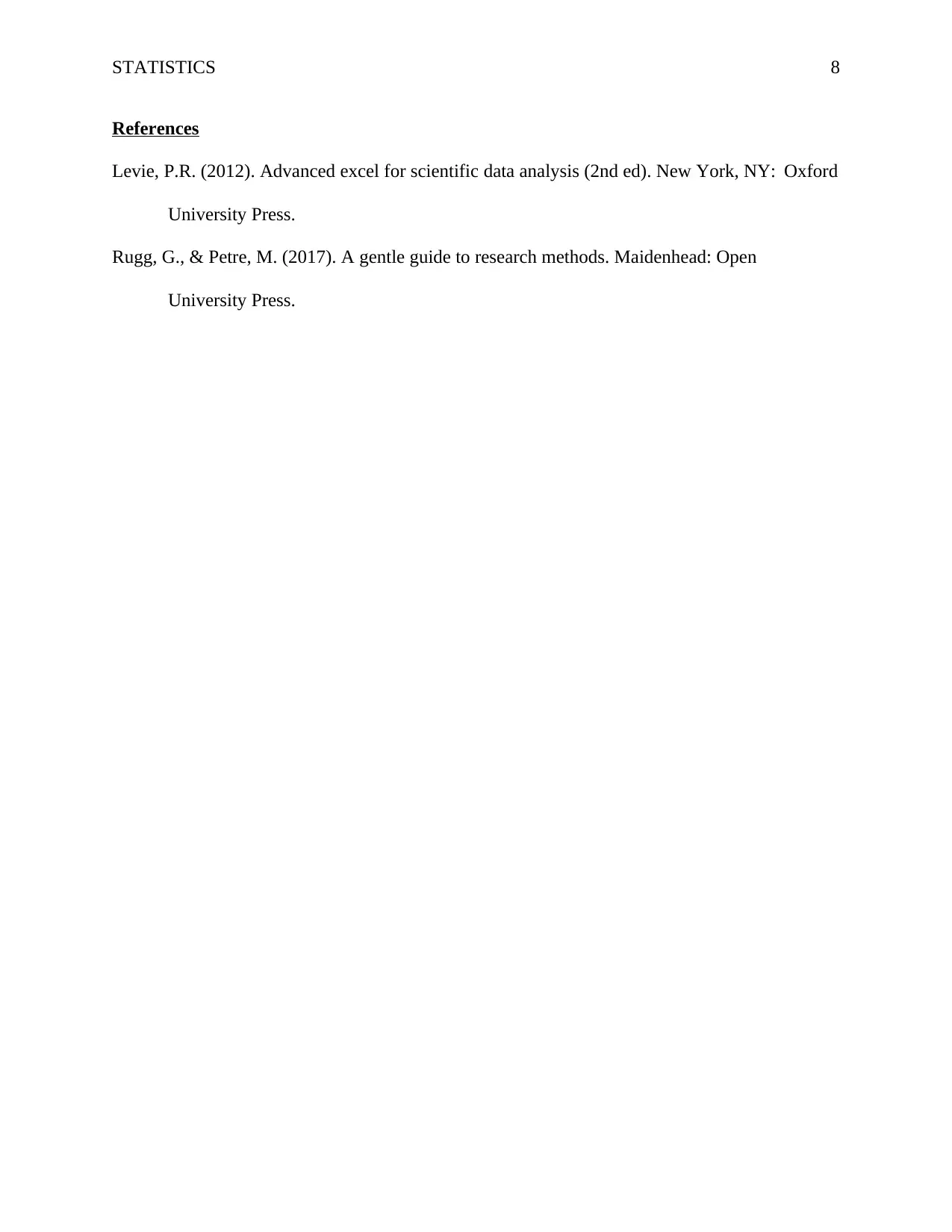
STATISTICS 8
References
Levie, P.R. (2012). Advanced excel for scientific data analysis (2nd ed). New York, NY: Oxford
University Press.
Rugg, G., & Petre, M. (2017). A gentle guide to research methods. Maidenhead: Open
University Press.
References
Levie, P.R. (2012). Advanced excel for scientific data analysis (2nd ed). New York, NY: Oxford
University Press.
Rugg, G., & Petre, M. (2017). A gentle guide to research methods. Maidenhead: Open
University Press.
1 out of 8
Related Documents
Your All-in-One AI-Powered Toolkit for Academic Success.
+13062052269
info@desklib.com
Available 24*7 on WhatsApp / Email
![[object Object]](/_next/static/media/star-bottom.7253800d.svg)
Unlock your academic potential
© 2024 | Zucol Services PVT LTD | All rights reserved.





